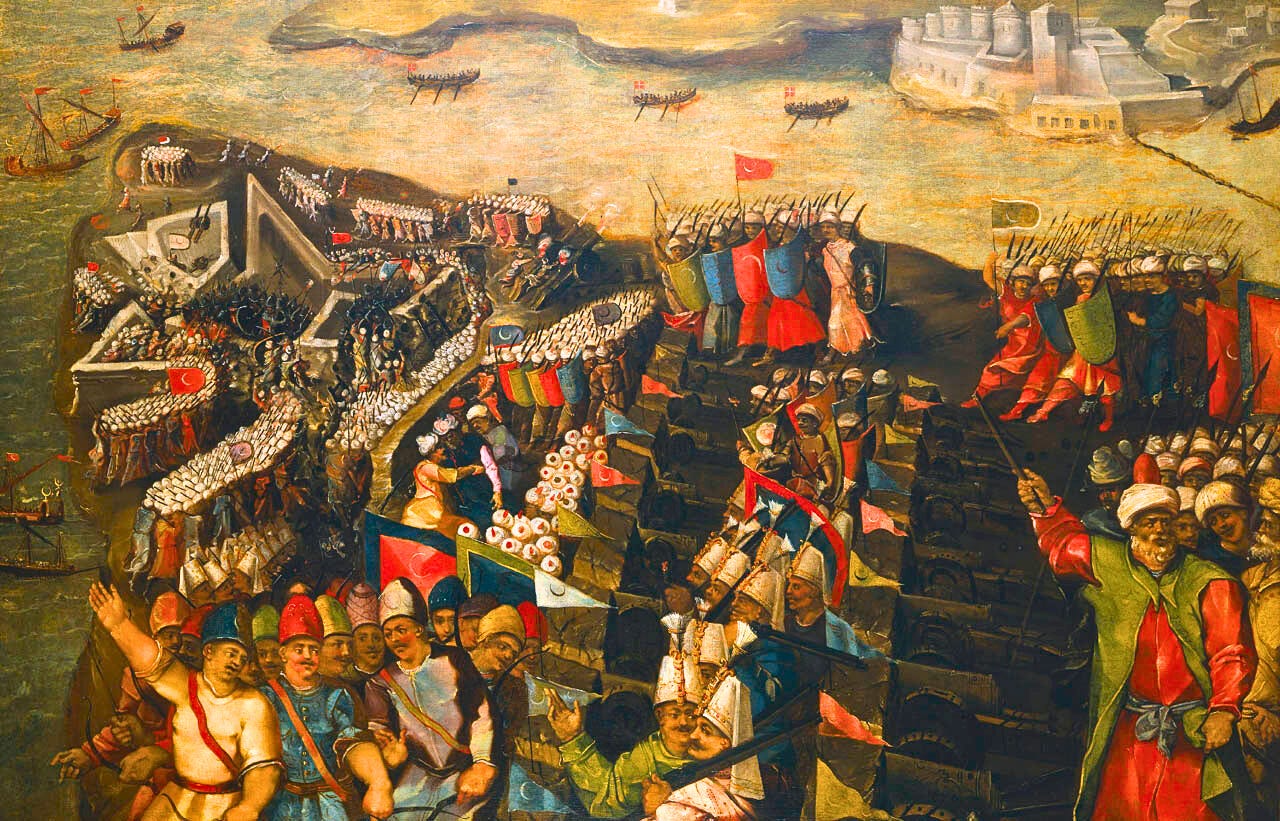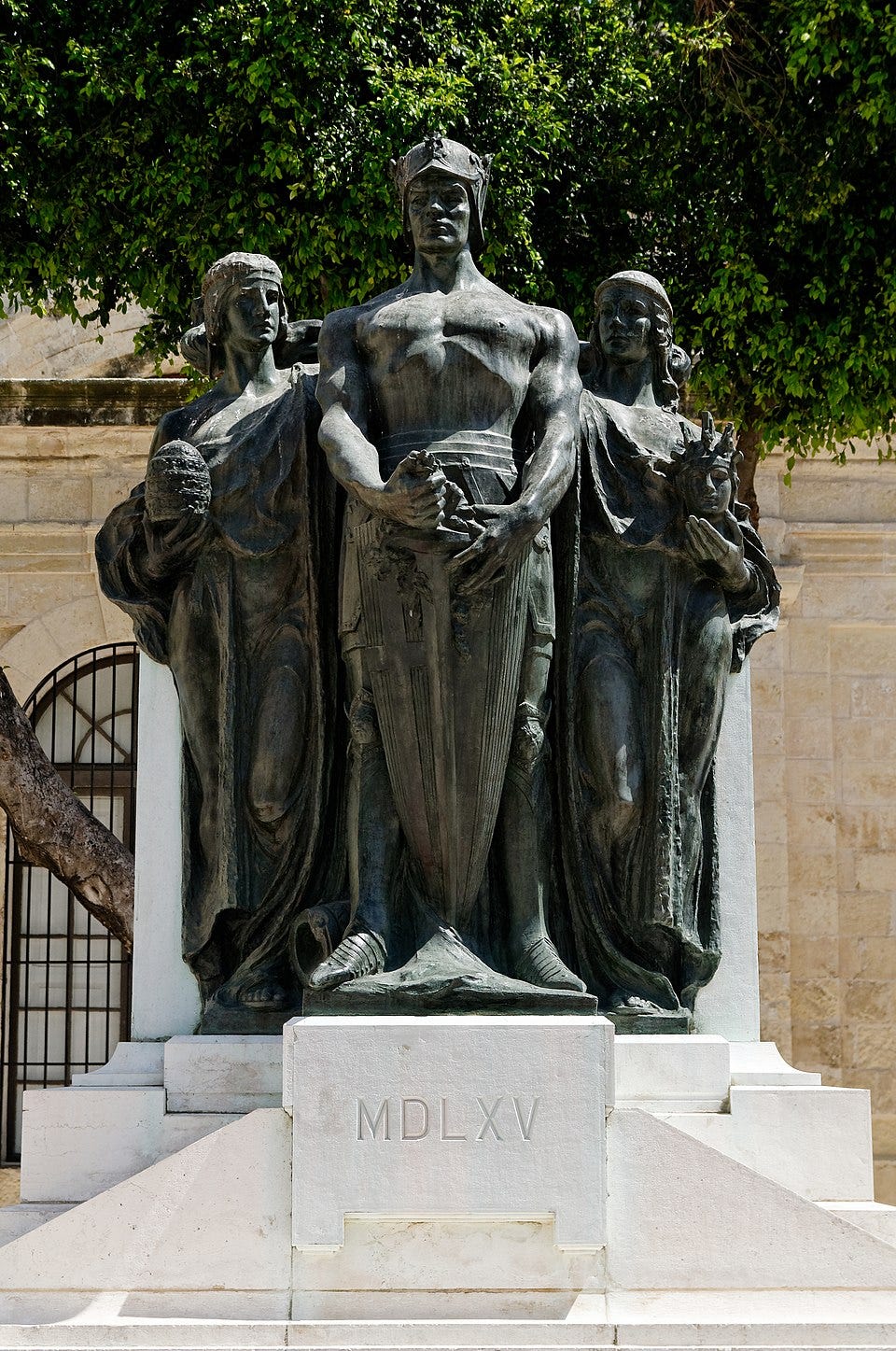How to Save Civilization
Knightly lessons from the greatest siege in history...
Nothing is better known than the Siege of Malta.
-Voltaire
In the summer of 1565, the island of Malta stood at the center of one of history’s fiercest sieges.
At the height of his power, Ottoman sultan Suleiman the Magnificent sent a fleet of 200 ships and an invasion force of nearly 40,000 men to conquer Malta and assert Islamic dominance over the central Mediterranean. The only thing standing in his way was a small force of just 6,000 men — a patchwork of knights, mercenaries, and Maltese farmers led by a 70-year-old Frenchman.
That man, Jean Parisot de Valette, was well acquainted with the Ottomans. Years earlier, he had watched helplessly from a distance as they enslaved the entire population — some 6,000 inhabitants — of a nearby island and sold them off in the slave markets of northern Africa. Ever since that day, he had been preparing for the Ottomans’ return.
Nothing, however, could have prepared him for an invasion of this scale. The first test came as the Ottomans threw 8,000 men at Fort Sant’Elmo, a small yet strategic fort held by just 150 knights and 600 volunteer soldiers. To lose it early was to lose all of Malta, and Valette knew only too well just what that entailed.
Through his leadership, Valette inspired the knights defending Sant’Elmo to keep fighting in the face of all odds, and the fort that should have fallen in days instead held out for weeks. The knights’ resilience bought valuable time for the rest of the island’s defenders, which ultimately saved not only Malta but all of the Mediterranean from Islamic domination.
Today, we explore what Jean de Valette can teach you about earning your authority through action and being willing to bear the burden you impose on others. We’ll see how, by doing so, Valette saved not only Malta, but all of Christendom itself…
The Great Siege of Malta began 460 years ago this week.
We’re sharing stories of what you can learn from the knightly heroes of history’s greatest siege.
To get 2 additional, members-only articles on Jean de Valette and Knights of Malta, click below to join INVICTUS now:
Forged by Fire
Long before he ever stepped ashore on the island of Malta, Jean Parisot de Valette had earned the right to lead.
Born into minor French nobility in the early 1490s, he joined the Order of the Knights of St. John (a.k.a. the Knights Hospitaller or the Knights of Malta) at a young age. The Order was a religious and military brotherhood dedicated to defending Christian lands and pilgrims from Islamic incursions. To join was to swear vows of chastity, poverty, and obedience, and to take up arms in the service of Christendom.
It wasn’t long before Valette experienced the trials of combat. He fought in the Siege of Rhodes in 1522, when the Ottoman Empire dislodged the Knights Hospitaller from their last stronghold in the eastern Mediterranean. He survived the months-long siege and the forced evacuation that followed. Years later, while commanding a patrol ship, he was captured by Barbary pirates and spent nearly a year as a galley slave — chained to an oar and rowing under the lash before being ransomed.
These trials left their mark, both physically and psychologically. Yet Valette emerged as a valiant and hardened warrior, and his reputation for integrity and austerity earned him steady promotion within the Order. In 1557, he was elected Grand Master, the supreme authority over the Knights of St. John and their territories.
By then, the Order had been granted control of Malta by Holy Roman Emperor Charles V. It was a relatively barren and rocky island, but strategically vital, for whoever possessed it controlled virtually all east–west naval traffic across the central Mediterranean.
For Suleiman the Magnificent, who was bent on expanding Ottoman influence westwards, Malta was an intolerable obstacle. For Valette, it was the last line of defense between Christian Europe and the surging Ottoman tide — and it was his duty to protect it…
The Siege Begins

On the 18th of May, 1565, the Ottomans arrived in Malta with overwhelming force: 200 ships, 40,000 men, elite Janissaries, massive siege guns, and the seasoned commander Dragut, the most feared admiral in the Islamic world. They wasted no time preparing siege lines, and soon turned their full attention to Fort Sant’Elmo.
Though small, the fort commanded the mouth of the Grand Harbor. Once it fell, the Ottomans could freely sail in to divide and destroy the island’s defenses. Expecting the fort to fall within days, Dragut ordered the bombardment to begin.
The fort’s defenders — 750 men at most — were battered daily by artillery, with as many as 500 cannonballs fired in a single day during peak assaults. The knights watched as their comrades died in droves, their walls were reduced to rubble, and their supplies dwindled. After weeks of fighting, they sent a formal plea to Valette, who was positioned on the other side of the harbor in Fort Sant’Angelo, asking his permission to withdraw and retreat.
Valette refused — the knights were to hold the fort at all costs.
It was, in essence, a death sentence. But the manner in which Valette conveyed his command made all the difference, for he did not respond with cold detachment or indifference to their suffering. Rather, he offered to cross the harbor and join them as they made their last stand.
Because of his reputation, the men at Sant’Elmo knew this was more than mere bravado. Valette had fought for the Order before — indeed, he had suffered and bled for it — and it was clear he was prepared to do so again now. It was this indisputable fact about Valette’s reputation that made all the difference.
Though it is unclear whether it was predominantly a sense of shame or inspiration after reading Valette’s response that spurred the knights into action, one thing is certain — not one man abandoned the fort. In fact, some knights stationed with Valette, upon learning of his response, even volunteered to cross the harbor and join their brothers as they made their last stand.
As for the knights at Sant’Elmo, they told Valette to remain where he was. His offer to fight alongside them had reminded them of the vows they had sworn upon entering the Order, and they resolved not to leave their post.
They would now sooner die than abandon what they were duty-bound to defend…
The Knights’ Last Stand
After over a month of continuous assault, Fort Sant’Elmo finally fell on the 23rd of June, and nearly every man was slaughtered as the Ottomans overran the fort. The defenders’ corpses were desecrated, tied to makeshift crosses, and floated across the harbor to the Knights' main stronghold as a warning.
But their sacrifice was not in vain.
The Ottomans had expected the fort to fall in four days. Instead, the weeks-long campaign had seen them lose over 2,000 of their best men, including the infamous commander Dragut. But most crucially, the Ottomans had lost time.
The month of resistance gave Valette the opportunity to reinforce the harbor cities of Birgu and Senglea, fortify their walls, organize his men, and rally the Maltese population. It also gave Europe time to respond. After a further two months of heroic defense on behalf of the knights — and of Valette himself, who is recorded to have fought with sword-in-hand on the front lines — a relief force arrived from Sicily.
Weakened and demoralized, the Ottoman invaders finally withdrew. Malta had held.
The heroic last stand of the Hospitaller Knights at Fort Sant’Elmo wasn’t a futile sacrifice, but the crux at which the fate of both Malta and Christian Europe hung in the balance. And even though the brave defenders themselves at one point thought to give up, they were persuaded by the example of the man who led them — a man who refused to give an order he wasn’t willing to carry out himself.
Valette’s actions, both during the siege of For Sant’Elmo and during the fighting at Birgu and Senglea, saved Christendom from Islamic conquest. It was a victory won not by sheer numbers or firepower, but rather by the authority of one who was willing to give his life for the greater good, and thus inspired his men to do just that.
Takeaways
1) Bear the Burden You Impose
Valette offered to die by the orders he issued. His willingness to join the doomed defense of Sant’Elmo gave the knights stationed there the resolve they needed to stand firm.
A leader’s orders carry weight only when he is willing to fulfill them himself. When others see you shoulder the consequences of your own decisions, they find the courage to do the same.
2) Earn Your Authority Through Action
Long before the siege began, Valette had bled, suffered, and sacrificed for the Order he served. So when the real crisis came, it was his reputation — not his rank — that moved others to follow him.
Likewise, real leadership is built through a lifetime of proven commitment. No command will hold when tested unless it has first been forged in character.
3) Don’t Undervalue Your Sacrifice
The fall of Sant’Elmo was inevitable, and the death of its defenders seemed a pointless sacrifice. But it was precisely their sacrifice that bought the others time and turned the tide of history.
Similarly, what looks like loss in the moment may be what ensures victory in the end. You won’t always be around to find out if your sacrifice was worth it — but it might bear far more fruit than you could ever imagine…
Want to dive deeper?
There is no live stream this week, but James and I will be back next Thursday!
As for this Thursday, our premium subscribers get a deep dive article exploring all the thrilling episodes from the Siege of Malta — the siege of Sant’Elmo being just one among many.
And on Saturday, premium subscribers get another deep dive article on the life of Jean de Valette, and how a lifetime of humility can make a man a hero.
If you’re not already a premium subscriber, please consider supporting our work and joining below:
Ad finem fidelis,
-Evan







Collapse is optional
Great reminder of how important these defenders of the west and Christianity were. There are many such cases, this is a great one. Thanks for sharing.